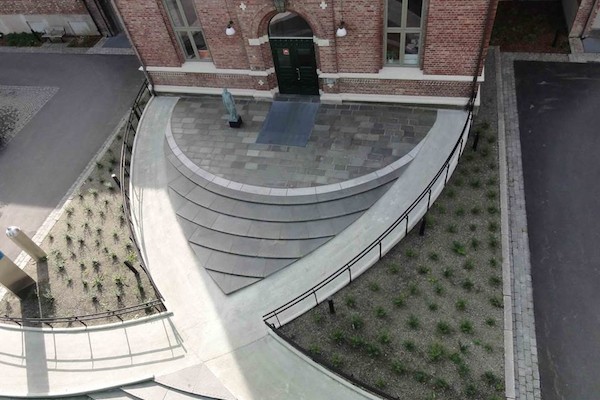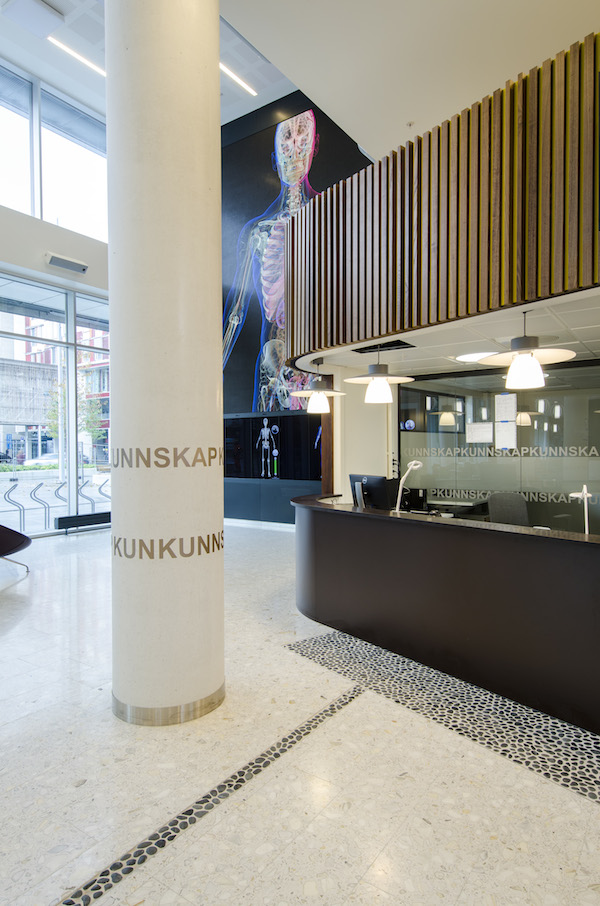At Knowledge of Design Week 2016, Onny Eikhaug spoke to Hongkongers about healthcare design that caters to everyone. She talks to Tamsin Bradshaw about myth-busting and smart solutions that benefit the community as a whole.

June 29th, 2016
Pictured above is the entrance to one of the buildings at St Olav’s Hospital, Norway. Here, wheelchair ramps and steps intersect in a design that is both functional and beautiful
This year, Hong Kong’s Knowledge of Design Week (KoDW) was all about the impact good design can have in the healthcare and wellness industries. Onny Eikhaug, Programme Leader, Design for All, at the Norwegian Centre for Design and Architecture (DOGA), was invited by Hong Kong Design Centre and event sponsors such as Create Hong Kong to be one of 20-odd speakers on this subject.
KoDW is an annual event that sees experts and stakeholders come together to share ideas, present best practices and debate the ways in which design can and should benefit the world. Under discussion at this year’s KoDW, hosted at Hotel ICON, was how design can enhance sustainability and quality of life in the face of rising urban density.
Responsible for promoting design for all as a tool for innovation through programmes such as The Innovation Award for Universal Design, Eikhaug spoke at KoDW about the value of design that’s accessible to everyone – no matter how old or young they are, and no matter what their physical or mental capabilities are. Here, she talks about why inclusive design is so important, and the many benefits that can come from taking this approach.
What is universal design, by your definition?
It’s a philosophy, a strategy and a process, and at many levels. You can have the ideological level based on human conventions. It can also be a very powerful tool for innovation. When you know your customers, you will get insights you can translate into concepts and new ideas. It’s a very rich source of inspiration for innovation.
When you talk about universal design in the official sense of the word, it’s about making sure products and environments are designed in a way that includes the widest range of people without any special adaptation. These solutions should be compatible with the mainstream solution. When you take into consideration that people have different levels of mobility, and different backgrounds, your solutions will be more robust and more inclusive. That in itself is very cost effective and efficient. As someone said in the St Olav’s video, it’s necessary for some, but better for everyone.
And when you start designing this way, you realise that your solutions are smart and better for everyone, and there’s no stigma involved. It’s easier to use a solution when it’s intuitive, and when you have different ways of accessing it. There’s also a lot of time saving with smart solutions. It’s really logical: why should you make solutions that only a part of the population can use?

St Olav’s Hospital, one of winners of Norway’s 2015 Innovation Award for Universal Design
What is the value of statistics versus emotion?
You cannot avoid statistics, and big data will give you a lot of information. You can get data about the fact that everyone is travelling at 10am, but you don’t know why or how. When you start asking people these questions and finding out why, you will end up with solutions that are much more innovative.
But I think that both are important… I think you really need to start with user research.
St Olav’s was one of the winners of the Innovation for All Award in 2015. It was a huge, 10-year project; how did they successfully deliver on their promise to create an inclusively designed hospital?
They had a very dedicated project team involving management from the very start. They agreed on a vision, on guidelines and design principles that were not to be debated. You have to have stamina and fight for those guidelines. Sometimes there were conflicting interests, and sometimes they had to involve other people in solving those interests.
To give you an example, in Norway, there is a lot of snow and slippery ice; we have very cold winters. St Olav’s had this parking for people with disability. They had agreed there needed to be these ice- and snow-free zones so that anyone could get from the parking to the hospital with ease. But in the end, they hadn’t done that. How can you have an inclusively designed hospital when people can’t get from their car to the hospital? Not acceptable, so they had to redo it. And sometimes the wall-hung toilets were at the wrong height. So they had to tear them down and do them again.
The St Olav’s team said, however, that because they were really well planned, most of the time they got it right first time. They didn’t compromise, and they stuck to their guidelines. The people representing the user groups were always on the project team – they were there making decisions. If they were just consulted and other people were making the decisions, they would probably have compromised when it came to those really difficult decisions.

Accessibility for all at St Olav’s
In your talk at KoDW, you also spoke about a hypoallergenic hotel in Norway. Tell us more….
The hotel’s design had positive impacts they didn’t foresee. They did this allergy friendly design with the guests in mind, but they didn’t anticipate the impact it would have on their staff. The staff found they didn’t need to take heavy allergy medicine, so they ended up taking less sick leave.
This hotel has become very popular for conferences because it can accommodate all sorts of guests, and also for staff as well.
It is also a good example because it busts one of the myths about universal design, which is that universal design is ugly and not aesthetically attractive. This hotel proves that it’s not true. It’s just perfectly designed, it’s beautiful.
Knowledge of Design Week
kodw.org
The Norwegian Centre for Design and Architecture
doga.no
A searchable and comprehensive guide for specifying leading products and their suppliers
Keep up to date with the latest and greatest from our industry BFF's!

The Sub-Zero Wolf showrooms in Sydney and Melbourne provide a creative experience unlike any other. Now showcasing all-new product ranges, the showrooms present a unique perspective on the future of kitchens, homes and lifestyles.

Channelling the enchanting ambience of the Caffè Greco in Rome, Budapest’s historic Gerbeaud, and Grossi Florentino in Melbourne, Ross Didier’s new collection evokes the designer’s affinity for café experience, while delivering refined seating for contemporary hospitality interiors.

Savage Design’s approach to understanding the relationship between design concepts and user experience, particularly with metalwork, transcends traditional boundaries, blending timeless craftsmanship with digital innovation to create enduring elegance in objects, furnishings, and door furniture.
The internet never sleeps! Here's the stuff you might have missed

Dallas Rogers, Head of Urban Discipline at the School of Architecture, Design and Planning, University of Sydney, comments on the history of map-making in our cities.

Available now across Australia, Eden TPO is setting new standards in terms of not just sustainability, but also style.